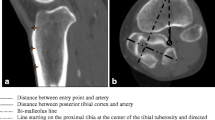Abstract
Purpose
Methods to administer intramedullary medication and fluid infusion in both adults and children date to the early twentieth century. Studies have shown that intraosseous access in the proximal tibia is ideal for resuscitation efforts as fewer critical structures are at risk, and neither is the blood flow to the lower limbs compromised. Insertion of a needle in children younger than 5 years does have the risk to damage to the epiphyseal growth plate. Therefore, the aim of this study was to determine the ideal intraosseous insertion site distal to the epiphyseal growth plate in neonates.
Methods
The samples consisted of both the left and right sides of 15 formalin-fixed neonatal cadavers. The dimensions were measured on the superior surfaces of each section, anteromedial border, cortical thickness, and medullary space.
Results
The most desirable location to gain vascular access is at 10 mm inferior to the tibial tuberosity.
Conclusion
The smallest cortical thickness (1.32 mm), the largest medullary space (4.50 mm), and the largest anteromedial surface (7.72 mm) were observed at 10 mm inferior to the tibial tuberosity. It is imperative that health care professionals are familiar with the osteological sites that could be safely used for an intraosseous infusion procedure.

Similar content being viewed by others
Data availability
The quantitative and qualitative data used to support the findings of this study are included within the article, and additional data may be requested from the corresponding author.
References
Abe KK, Blum G, Yamamoto LG (2000) Intraosseous is faster and easier than umbilical venous catheterization in newborn emergency vascular access models. Am J Emerg Med 18:126–129
Bland JM, Altman DG (2010) Statistical methods for assessing agreement between two methods of clinical measurement. Int J Nurs Stud 47:931–936. https://doi.org/10.1016/j.ijnurstu.2009.10.001
Boon J, Gorry D, Meiring J (2003) Finding an ideal site for intraosseous infusion of the tibia: an anatomical study. Clin Anat 16:15–18. https://doi.org/10.1002/ca.10071
Chokshi NK, Nguyen N, Cinat M (2010) Access in the neonatal and pediatric patient. Vascular access: principles and practice. Lippincott Williams & Wilkins, Philadelphia, pp 139–147
Clemency B, Tanaka K, May P et al (2017) Intravenous vs. intraosseous access and return of spontaneous circulation during out of hospital cardiac arrest. Am J Emerg Med 35:222–226. https://doi.org/10.1016/j.ajem.2016.10.052
Ellemunter H, Simma B, Trawöger R, Maurer H (1999) Intraosseous lines in preterm and full term neonates. Arch Dis Childhood Fetal Neonatal Ed 80:F74–F75
Hafeez W, Ronca LT, Maldonado TE (2011) Pediatric advanced life support update for the emergency physician: review of 2010 guideline changes. Clin Pediatr Emerg Med 12:255–265
King ML, Moses EC (1990) Intraosseous infusion: a lifesaving technique. Nursing (Lond) 20:32K-32N
Lowe J, Anderson P (2015) Musculoskeletal system. In: Stevens & Lowe’s human histology. pp 239–262
Phillips L, Brown L, Campbell T et al (2010) Recommendations for the use of intraosseous vascular access for emergent and nonemergent situations in various healthcare settings: a consensus paper. J Emerg Nurs 36:551–556. https://doi.org/10.1016/J.JEN.2010.09.001
Ryder IG, Munro HM, Doull MIJ (1991) Intraosseous infusion for resuscitation. Arch Dis Child 66:1442–1443. https://doi.org/10.1136/adc.66.12.1442
Wald SH, Mendoza J, Mihm FG, Coté CJ (2019) Procedures for vascular access. A practice of anesthesia for infants and children, 6th edn. Elsevier, Amsterdam, pp 1129–1145
White TD, Black MT, Folkens PA (2011) Leg: femur, patella, tibia, and fibula. Human osteology. Academic press, Cambridge, pp 241–270
Acknowledgements
The authors sincerely thank those who donated their bodies to science so that anatomical research could be performed. Results from such research can potentially increase mankind's overall knowledge that can then improve patient care. Therefore, these donors and their families deserve our highest gratitude. Additionally, the authors would like to thank Prof. JM Boon and Ms. D Naidoo for making the initial cuts of the tibias.
Funding
The authors declare that this research and publication is not funded by any financial supporting body.
Author information
Authors and Affiliations
Contributions
All the authors had substantial contributions to the conception of the work, analysis, or interpretation of data for the work. This included drafting the work or revising it critically for important intellectual content. The final version of this document was approved by all the authors before submission. Additionally, all the authors agreed to be accountable for all aspects of the work in ensuring that questions related to the accuracy or integrity of any part of the work are appropriately investigated and resolved. DJvT contributed to protocol development, data collection, data analysis, and manuscript writing. MLvN was involved in protocol development and manuscript editing. AvS contributed to project development, data collection, data analysis, and manuscript editing.
Corresponding author
Ethics declarations
Conflict of interest
The authors declare that there is no conflict of interest regarding the publication of this paper.
Ethics approval
This research was part of a research project at the University of Pretoria, which was submitted to and approved (Ethics clearance: 447/2018) by the Ethics Committee at the University of Pretoria. We certify that this study was performed in accordance with the ethical standards as laid down in the 1964 Declaration of Helsinki and its later amendments or comparable ethical standards.
Additional information
Publisher's Note
Springer Nature remains neutral with regard to jurisdictional claims in published maps and institutional affiliations.
Rights and permissions
About this article
Cite this article
van Tonder, D.J., van Niekerk, M.L. & van Schoor, A. Proximal tibial dimensions in a formalin-fixed neonatal cadaver sample: an intraosseous infusion approach. Surg Radiol Anat 44, 239–243 (2022). https://doi.org/10.1007/s00276-021-02843-1
Received:
Accepted:
Published:
Issue Date:
DOI: https://doi.org/10.1007/s00276-021-02843-1




